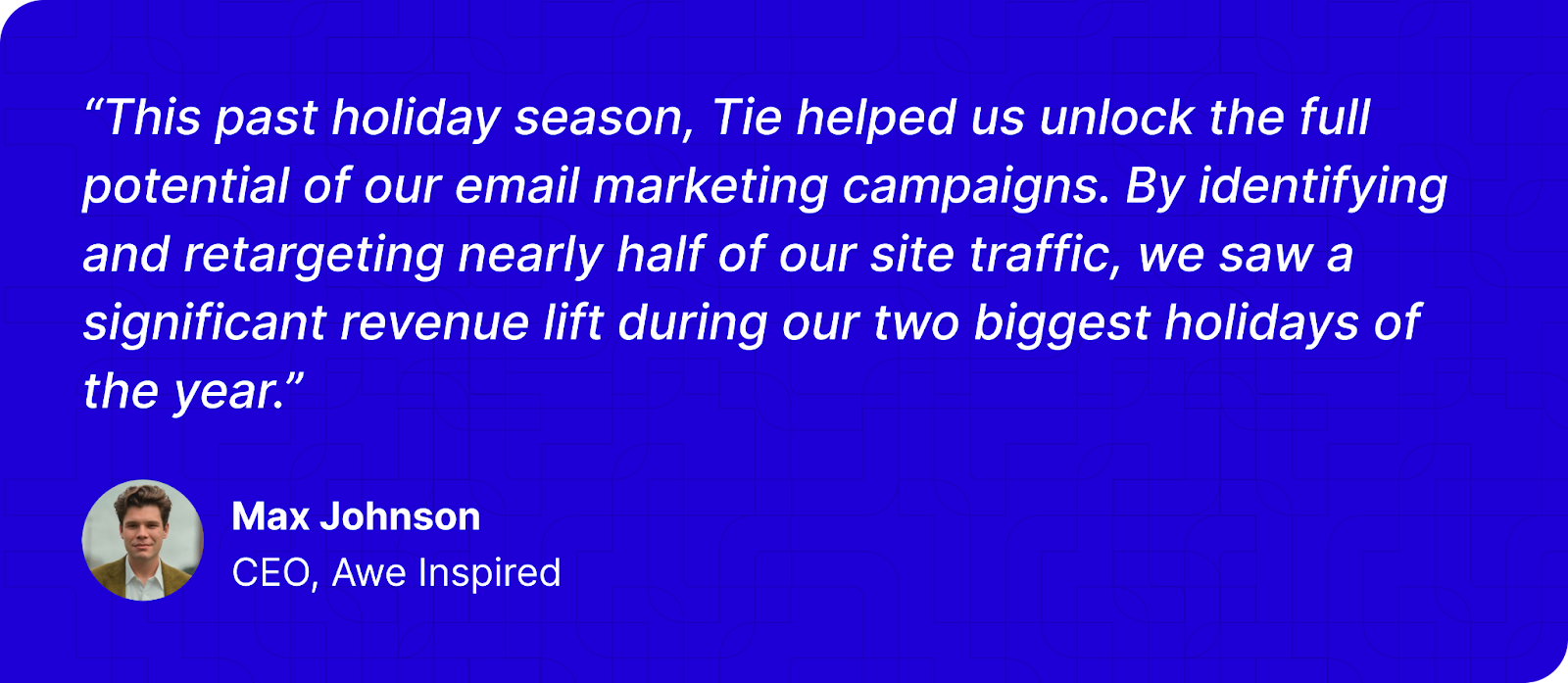How Accurate Data from Identity Resolution Networks Improves Customer Targeting
.png)
Customer targeting relies on accurate, up-to-date, and complete information. But, data is often fragmented across multiple platforms—CRM, email lists, ad networks, and analytics tools— causing duplicate, inconsistent, or incomplete records. What’s worse, your customer data likely has information gaps, missing critical insights that help you understand and communicate with customers effectively.
Without accurate and well-consolidated customer data, businesses face many problems:
- Ads reach the wrong users or existing customers instead of new prospects.
- Generic messaging causes low engagement and reduced conversions.
- Inefficient targeting, which increases acquisition costs and lowers ROI.
- Missed opportunities due to unidentified anonymous visitors and inaccessible key attributes like intent, lifecycle stage, and specific demographics.
This is where identity resolution networks come in. By consolidating your data from different sources, they help you create a single, unified customer profile. This gives you accurate data to allow precise targeting, optimize your marketing campaigns, personalize your efforts, and drive conversions.
What is identity resolution?
Identity resolution is the process of accurately recognizing and linking people across multiple channels and devices to create a unified view of their customer profile.
This is done by:
- Collecting data from various sources (website, CRMs, ad platforms, etc)
- Cleaning and standardizing it to remove duplicates and inconsistencies.
- Matching user identities across touchpoints.
- Enriching customer profiles with attributes that businesses don’t usually have access to.
Identity resolution networks use 2 types of matching techniques to maximize data accuracy:
- Deterministic matching uses known and unique identifiers like email and account information.
- Probabilistic matching is based on cross-device and behavioral data to infer identities.
Why accurate identity resolution data is critical for customer targeting
Customer data is at the core of every successful marketing strategy, but if it isn’t accurate and comprehensive, businesses face wasted ad spend, poor engagement, and missed revenue opportunities.
Let’s go into detail on why identity resolution is important for efficient customer targeting.
#1: Eliminates the problem of fragmented and incomplete customer data
Customer data is usually spread across CRMs, ad platforms, social media, and analytics tools, causing duplicate, incomplete, or inconsistent records. Disparate data makes it difficult to understand your customers effectively, reducing the effectiveness of your marketing and retargeting efforts.
Identity resolution fixes this by linking your customer data across multiple touchpoints, channels, and platforms into a single customer profile. It combines your first-party and enriches it with third-party data by tapping into a network of vetted data sources. This means:
- You uncover anonymous shoppers and effectively identify them.
- You get access to specific details about your customers that standard purchasing journeys didn’t uncover.
- You understand customer behavior and intent better.
For example, Jordan Craig, a fashion ecommerce brand had over 1 million subscribers, that they couldn’t tap into. By leveraging visitor identification, the fashion brand was able to identify 50% of its site visitors to retarget them, driving an additional $70K in revenue through their efforts.
Solving this foundational issue with your customer data helps you with all the other aspects of your marketing and customer targeting.
#2: Improves ad spending with accurate targeting
Relying on third-party cookies and broad targeting often leads to ad mismatches, where businesses spend heavily on audiences that aren’t likely to convert. This results in:
- Higher customer acquisition costs (CAC) due to wasted impressions.
- Difficulty in measuring ROAS, as conversions are often misattributed.
- Overlapping campaigns targeting the same customers leads to wasted ad spend.
Identity resolution refines audience segmentation by matching anonymous visitors to known users and enriching first-party data. This allows businesses to create precise retargeting lists, eliminate duplicates, and improve the accuracy of lookalike audiences.
For example, Hollow Socks, an ecommerce apparel brand, had limited working capital, making every ad dollar count. However, inaccurate audience matching further reduced conversions, leading to wasted spend.
Leveraging identity resolution, Hollow Socks was able to identify and retarget 70% of their site traffic with precise audience segmentation.
The brand could then allocate ad spending more effectively on Meta and Google, achieving a 5x ROI and growing their email list by 50%+ in just two months.

#3: Better personalization and engagement
Another problem that identity resolution networks solve is your personalization efforts. Without accurate customer data, businesses struggle in a few ways:
- The inability to deliver relevant messaging means customers receive generic emails and ads, leading to low engagement and lower clicks.
- Cross-channel experiences are disconnected, delivering a poor customer experience.
But, with a comprehensive and accurate view of your customer and their interactions, personalizing your messaging and targeting is simpler. You can send promotions and recommendations that your customers would be interested in.
For example, Windmill, an ecommerce home goods brand, needed highly targeted marketing to maximize conversions while making sure that every interaction delivered strong ROI.
To solve this, Tie implemented identity resolution to improve audience targeting across various channels. This helped Windmill optimize retargeting with personalized messaging, increasing conversions.
By making sure that each marketing touchpoint was highly relevant and engaging, they achieved a 5x ROI.
#4: Improves cross-channel tracking
Ever logged the same person as two separate shoppers within your customer records? This is a common issue for brands these days. With omnichannel shopping options, many brands have a hard time tracking customers across multiple devices and platforms.
This means you're looking at inaccurate customer journeys where interactions across email, social media, website visits, and third-party marketplaces are not seamlessly connected. Data silos like these cause you to make inaccurate decisions, send out irrelevant promotions, and deliver poor customer experiences.
Identity resolution solves this, unifying customer data across devices and marketing channels to let you understand customer journeys better, deliver better cross-channel experiences, and keep your messaging consistent based on previous interactions.
#5 Reduces churn with better retention strategies
Many brands find it difficult to retain existing customers because their existing data has problems:
- Doesn't give them a clear picture of the different lifecycle stages that customers are on.
- Lacks context to anonymous shoppers, making it hard to contact them.
Due to this, brands miss out on easy opportunities to re-engage shoppers promptly and bring them back to make a purchase. Improving your customer data lets you leverage these retention opportunities:
- Identify anonymous shoppers who showed intent to purchase on-site or abandoned their cart and retarget them successfully.
- Use browsing and purchasing patterns to narrow down at-risk customers.
- Improve post-purchase experience by recommending relevant products based on browsing and buying history.
- Segment customers based on their behavior, intent, and specific attributes to send tailored promotions, like discounts for lapsed customers or loyalty benefits for repeat shoppers.
Read more about how you can increase your retention with better marketing data.
#6 Better marketing ROI
Identity resolution improves and enhances the data you’re working with to set up your marketing efforts. With better data, you can launch targeted, timely, and accurate campaigns.
Here’s how identity resolution improves your ROI:
- Reduces acquisition costs by avoiding wasted spending on unqualified or duplicate leads.
- Improves targeting accuracy by unifying customer profiles and helping you effectively communicate with customers with relevant messaging.
- Provides accuracy in attribution by tracking customer journeys across channels and devices in one place, along with multi-touch attribution to give a full view of your customers’ interactions with your brand.
- Increases conversion rates by making sure that your marketing messages reach relevant customers based on up-to-date and accurate information.
How to get started with anonymous identity resolution for customer targeting
Leveraging identity resolution to identify anonymous users like visitors to your website through cookies, device ids and IP addresses requires specialized data enrichment platforms like Tie.
Why do you need a specialized platform to enrich your customer datasets?
- Specialized algorithms: Data matching requires specialized algorithms built and managed by experts to accurately enrich your data.
- Access to third-party data sources: Data enrichment platforms have access to third-party sources that help in providing critical missing customer details.
- Compliance: The identity resolution process must be handled carefully, following compliance and privacy regulations. Your identity resolution partner has the expertise and infrastructure needed to successfully identify and enrich your data while keeping with compliance.
- Continuous updates: Identity resolution isn't a one-time process. Customer data constantly changes, (new behavior and devices, the addition of personal details, etc) which requires constant monitoring and accurate updates.
- Access to identity graphs: Experts leverage their proprietary cross-device identity graphs to consolidate customer data across devices.
Since anonymous identity resolution requires a larger data set built with expertise from data scientists and machine learning engineers, most platforms specialize in either consumer data (B2C) or business data (B2B) and struggle to identify more than 20% of anonymous traffic, but since Tie’s identity graph is one of the largest B2C identity graphs in the US, it can identify up to 90% of US traffic to a brands website.
Features to look for in a data enrichment platform
When looking for a data enrichment platform, it’s essential to choose one that delivers the results you’re looking for. But how can you tell if the platform you choose is right?
High match rates
The partner you choose should offer accurate identity resolution capabilities, giving you access to complete customer profiles.
Choose platforms with match rates as high as 50% and the ability to deliver insights as deep as the level of intent, filtering criteria, and recency of data.
Compliance
Data enrichment platforms need to work with fully opted-in data sources. Check their compliance standards, ensuring that they follow privacy regulations like GDPR, CCPA, etc.
Identity graphs
Identity graphs are an essential aspect of identity resolution. Platforms need it to accurately recognize, track, and match customers across multiple touchpoints.
Access to Extensive Data Sources
A good identity resolution partner would have access to an identification network with thousands of vetted data sources to accurately identify and match web visitors and enrich your customer data.
Seamless integration
Look for data enrichment partners who automate data streaming onto your existing platforms like Google, Meta, CRMs, ad networks, etc. Avoid platforms that opt for manual data uploads.
Reporting
The platform should provide deep insights into visitor behavior, campaign performance, etc, with real-time reports that simplify how you understand and handle your data.
Pricing
The data enrichment partner you choose should fit your budget, allowing you to effectively improve your datasets and allow better customer targeting while aligning with your budget allocation and expected ROI.
What are the steps to implementing customer identity resolution for your ecommerce brand?
Different platforms have their own processes. Here’s what working with our team at Tie would look like:
1. Initial consultation and alignment
We start by setting context and understanding your specific goals and challenges to tailor our approach to your requirements.
2. Secure access sharing
Your team grants us access to your website, ESP, Google, Meta, and DNS.
3. Implementation
Typically implementation happens within 1 business day via a white glove service.
4. Onboarding
Once approved by your team, we stream this data into your marketing platforms, allowing you to use it easily. Our Customer Success team works with you to configure Tie to meet your teams goals and de-anonymize the web traffic most valuable to you.
5. Support and optimization
Our team provides ongoing support, monitoring performance, and making adjustments to improve identification rates and maintain accurate customer profiles.
Why choose Tie over other identity resolution partners
Here’s how Tie compares with other identity resolution partners in the market, delivering better data enrichment, audience, segmentation, and marketing optimization at a fraction of the cost:
- Highest match rate: Tie guarantees a 50%+ audience match rate, more than competitors whose match rate ranges from 15-35%.
- Access to 1K+ consumer attributes: Tie goes beyond basic contact details like name and phone number, providing comprehensive enrichment with niche demographics like marital status, net worth, etc. It also taps into IP address data to enhance location-based insights. Most importantly, Tie consolidates ad ID, allowing you to accurately and effectively retarget.
- Deep audience filtering capabilities: Get detailed insights into visitor web behavior, data quality score, subscriber types based on intent, purchasing behavior, etc.
- Fully compliant: Tie integrates into any consent management platform. They also receive verified explicit opt-in from data partners.
- Costs 5x less than competitors: Tie charges based on usage, costing less than $0.01 per identified user.
- Built-in email deliverability tool: Beyond data enrichment, Tie also provides support with domain warming and email engagement simulation to optimize your sender reputation and maximize your marketing efforts.
- Access to real-time analytics and reporting: Clients see a significant increase in conversion rates with their marketing efforts after availing Tie's data enrichment services.
Strategy Breakdown: how Awe Inspired increased revenue with Tie
Awe Inspired, a jewelry ecommerce brand, faced challenges in tracking and leveraging customer insights. Their previous vendor provided limited visibility into data collection, making it difficult to attribute conversions and optimize retargeting efforts. So, they used Tie which allowed them to:
- Identify anonymous visitors and match them with real customer profiles.
- Enrich audience segments with demographic and behavioral data.
- Enable real-time data streaming, improving marketing campaign performance.
The result?
- 43%+ onsite visitor identification rate, improving retargeting reach.
- 5.0x ROI from improved audience targeting and engagement.
- $143K in additional revenue, directly attributed to better customer identification.

Ready to leverage identity resolution networks for your customer targeting?
Identity resolution eliminates data silos, unifies customer identities, and plugs in new data points to give businesses access to comprehensive data about their customers. With this, you can set up more accurate and effective customer targeting to engage the right audience, set up personalized marketing campaigns, and maximize your ad spend.
Turn anonymous visitors into engaged customers with Tie’s Identity Resolution.
Get accurate, actionable data. Book a demo today!
Frequently asked questions
How does identity resolution impact compliance with data privacy regulations?
Identity resolution is compliant with data privacy regulations. The right identity resolution platform partners with trusted data providers to acquire fully opted-in consumer data.
It adheres to privacy data governance laws like GDPR, CCPA, and HIPAA.
How do identity resolution networks integrate with existing marketing tools?
Identity resolution networks, like Tie, integrate with ecommerce platforms, email marketing services, ad networks, CRMs, and customer data platforms (CDPs, DMPs, etc) through APIs or direct platform access to unify user profiles.
This is manually set up by the team once they have access to your website, ESP, Google, Meta, and DNS.
How to measure the revenue you are generating because of identity resolution?
The revenue that you generate after implementing identity resolution is based on your customer targeting and marketing efforts. You can understand the impact of identity resolution on your growth strategies and measure the revenue you’re generating by tracking these key metrics:
- Customer lifetime value (CLV): Accurate data allows you to deliver more personalized customer experiences, leading to higher retention, more repeat purchases, and higher AOVs from existing customers. Compare CLV before and after implementing identity resolution.
- Marketing ROI: With more relevant marketing efforts that rely on unique insights about your customers, you’re likely to see higher conversion rates, higher return on ad spend (ROAS), and lower customer acquisition costs (CAC).
Attribution accuracy and optimized spending: With an accurate and unified view of your customer interactions, identity resolution tracks conversions across multiple touchpoints and channels effectively. If you're seeing higher accuracy in conversion attribution and optimized marketing spend, it's a sign of identity resolution's impact.






